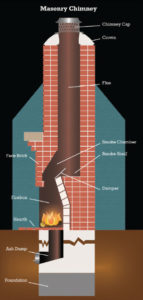While opening and closing the damper may seem like more of an inconvenience than anything else, it has a surprisingly important role in your fireplace system. Because of this, a damaged damper can impact the safety and efficiency of your fireplace system.
can impact the safety and efficiency of your fireplace system.
What is a damper?
Most homes with wood burning fireplaces have what is known as a throat damper. Located at the top of the firebox, the damper is used to seal off the firebox from the flue. Opened and closed using a pulley or lever system, the damper should always remain open the entire time the fireplace is in use; this allows smoke, hot air, and gas to easily draft up the chimney.
The importance of dampers
While seemingly insignificant, dampers are important to both the functionality and safety of a wood burning fireplace. Dampers serve a number of purposes; one of the ways dampers help the fireplace system is by preventing the loss of heated and cooled air. This, in turn, can reduce energy bills as less conditioned air is lost to the outside.
In addition to reducing your utility bills, dampers can protect your firebox – and home – in the event of a chimney leak or animal entry. As a closed damper seals off the chimney from the firebox, animals, water, and other debris cannot get into the firebox when the damper is closed. This helps protect the refractory masonry in the firebox – as well as keeps birds, squirrels, raccoons, and other animals out of your living room.
Is my damper damaged?
Dampers are commonly damaged from exposure to water from a chimney leak, years of exposure to heat from the fireplace, or simple wear and tear. The following are three signs your damper may be damaged.
- Broken lever or pulley: If you can no longer open or close the damper using the pulley or level, the damper may become stuck open, closed, or somewhere in between.
- Rust on the damper: The presence of rust or oxidization on the damper is only caused by exposure to water. If rust appears, it typically means a chimney leak is also present.
- Loss of airtight seal: When closed, dampers should completely cut off airflow from the flue to the firebox. Exposure to heat can warp this seal and allow hot and cold air to pass up and down the chimney system.
If your damaged damper needs to be replaced, consider switching to a top mounted damper. Located at the top of the chimney where a chimney cap would sit, top sealing dampers closed the entire flue and firebox off from outside air. Doing this can help reduce heating and cooling costs, make it easier to start fires, and help prevent animals or debris from entering the chimney. Top sealing dampers can also be used along with a throat damper to maximize efficiency.
A damaged damper can impact the safety and efficiency of your fireplace system – as well as impact your heating and cooling costs. To save money and make your fireplace safer to use, have your damper replaced as needed; to have your damper inspected, repaired, or replaced, contact Mason’s Chimney Service today!
